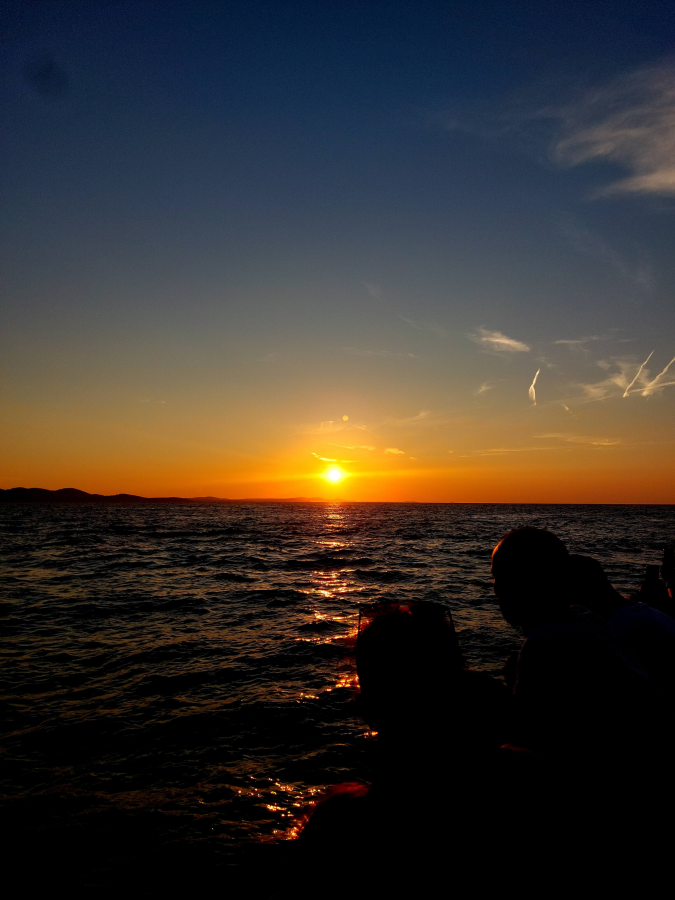After wonderful stays in Split & Šibenik, we decided to visit Zadar. Just a relaxing one hour bus ride further on, along the beautiful Dalmatian coast.
- The port city of Zadar has well over 70 000 inhabitants.
In this post I will tell you all about our visit. As well as, give you tips and ideas for Things to do in & around Zadar.

This blog post is written with the help of my daughter Lisa, who shared her own experiences with me touring Croatia.
- IMPORTANT MESSAGE: Throughout this post you’ll find affiliated links & ads provided by the travel platforms like TravelPayOuts & GetYourGuide. Links & ads that may help you plan & fill in your next trip to Croatia.
- If you click on them & buy a ticket for a museum or a tour a small commission of your purchase will go to me. (Paid by the provider, without any extra cost to you!).
- If you first want to learn a little bit more about me, the blog writer, please click on: Better call me Art.

Historical introduction to Zadar
Zadar’s early start
The history of Zadar goes way back. It’s actually the oldest continuously inhabited city in Croatia.
Although Prehistoric human remains have been found in & around the city, its formal history begins in the 9th century BC. The moment a local tribe, the Liburnians, decided to build a settlement on a small stone islet
A special location which was tied to the mainland by a narrow, overflown isthmus. A spot where the old city still stands today.

This first settlement was already an important trading post when the Phoenicians – and later on the Greeks & the Romans – became rulers of the Mediterranean.
Roman period
The Romans actually incorporated Zadar in their Empire, from the second century BC onwards. Transforming the place little by little in a typical Roman city, leaving its marks until today.
- Marks like the Roman Forum, which remains are still visible in the city center. Or the Aqueduct, which was built to bring water from Lake Vrana (Vransko) – located at 40km/25mi. distance – to Zadar’s inhabitants.

From the 3rd century onward, Zadar & surrounding area little by little converted to Christianity. Something which happened throughout the whole Roman Empire
After the Fall of Rome
After Rome’s decline, Zadar fell to the mercy of Barbarian & local tribes. As a consequence many Roman structures were destroyed. Not only through war, but also because of a heavy earthquake that hit the city during the 6th century.
- Between the 6th and 11th century Zadar was threatened & conquered by many different European power groups. To name a few: the Huns, the Ostrogoths, the Byzantines, and later on the Venetians & the Franks.
Venetian Rule
Despite all these challenges, Zadar survived & even thrived as a maritime power. Rivaling the upcoming city of Venice economically & culturally. That is, until the 15th century when Venice reached its peak & gained control of many surrounding areas, including Zadar. Again, leaving the city architectural marks, which are still visible today.
- The Venetians decided to build a protective wall around Zadar – mainly against Ottoman threats. A wall which included several defensive towers, like the Bablja Kula. An impressive construction, which was restored recently & open to the public. Providing visitors with beautiful views of Zadar & surrounding area.

Modern history of Zadar
From the end of the 18th century large parts of modern-day Croatia belonged to the Austrian Empire, including Zadar.
After the collapse of the Hapsburg dynasty (1918) though, the port city became part of Italy. In that capacity it suffered heavy bombardments when the Allies – at the end of 1943 – started liberating Europe from the Axis powers.
After the war, Zadar was ceded to the new state of Yugoslavia. Until 1991, when Zadar became officially part of an Independent Croatia. It would take another 4 years though, before the war between the fighting parties in former Yugoslavia ended. Time in which Zadar & the surrounding still suffered many losses & devastation.
In short, Zadar has suffered a lot during its long history.

Visit Zadar: Main attractions in the city center
The Historical center of Zadar
Like in Split, Šibenik, Dubrovnik & other Croatian cities, Zadar’s main attraction is its old city center. A perfect area to stroll around at your own pace & take it all in.
Soon enough you’ll notice that Zadar’s small city center is provided with a lot of churches. In many cases these churches are built over Roman foundations – some visible, others still hidden.
- Because Zadar’s city center has suffered a lot in the past – like wars, sieges, earthquakes & flooding – you’ll spot many “newer” buildings, spread among the much older monuments.
Top #3 churches
All Zadar’s churches have their own history & attracting features, but if I have to name the three most interesting ones, the Top #3 would be:
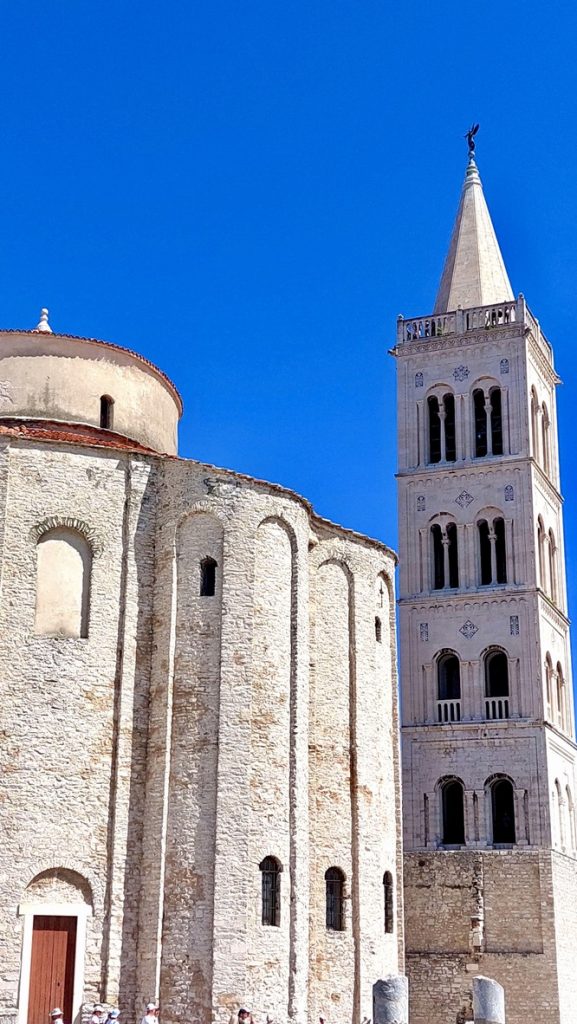

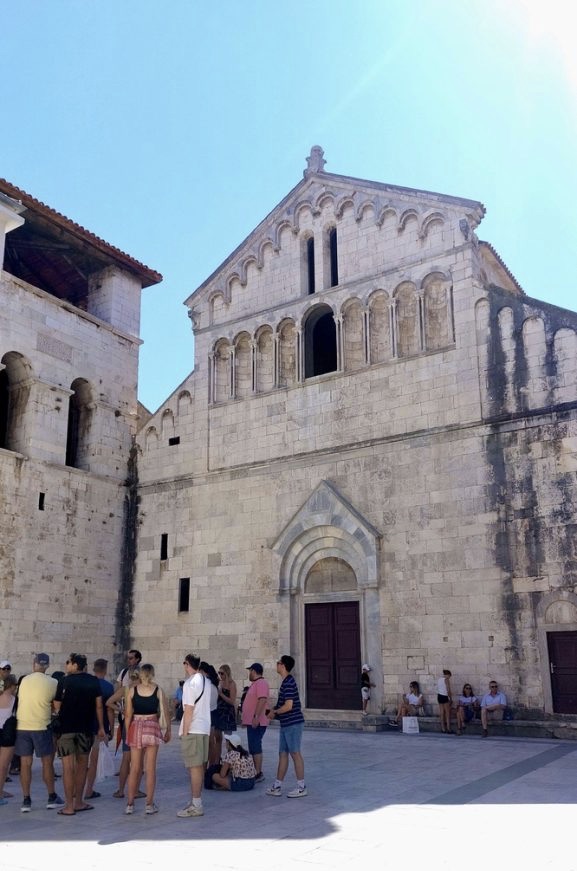
Zadar’s city center is known for its many churches.
From left to right:
- The Church of Saint Donatus (completed in 9th century)
- Santa Anastasia’s Cathedral (although one of the oldest churches of Zadar, this cathedral was largely rebuilt during the 13th century).
- The Church of Saint Chrysogonus (which was consecrated in 1175).
All impressive structures, which will surely catch you eye strolling around the inner city. And if lucky, invite you in to have a look at their interiors.
- Although the older – mostly Roman – foundations were hidden for centuries, several churches have opened up the past & made it visible for the public. Not only the base foundations, but also old columns, statues & fresco’s.
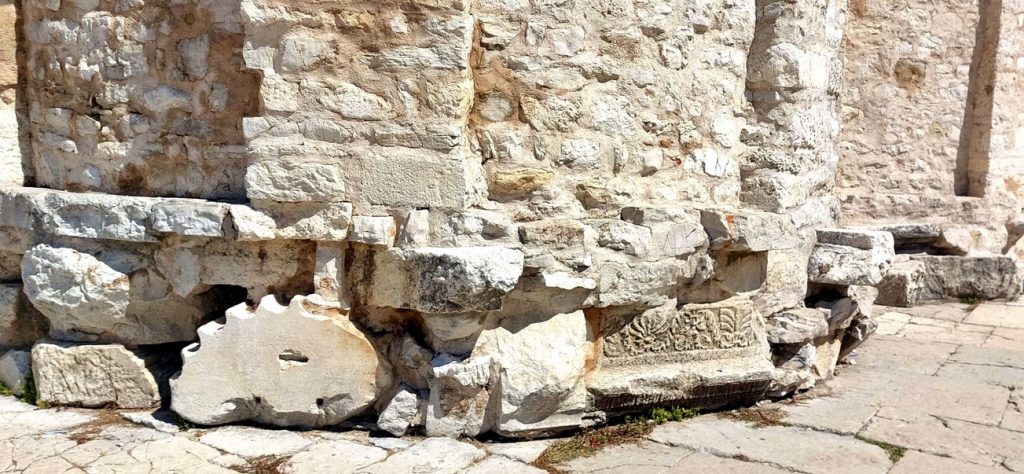
TravelTip: Please be aware that there’s a dress code to visit the churches of Zadar. Don’t go in on your flip flops, wearing shorts, uncovered legs or shoulders. That goes for all Holy places in Croatia, and – let’s be honest – Worldwide.
- In many churches throughout our journey through Croatia, we noticed employees providing female visitors a shawl to cover their shoulders before entering.
Roman remains
Besides the old remnants underneath, in & around Zadar’s churches you can spot Roman remains throughout the city. Like the earlier mentioned Forum (founded by the Roman Emperor Augustus), the Aqueduct & several Roman columns.
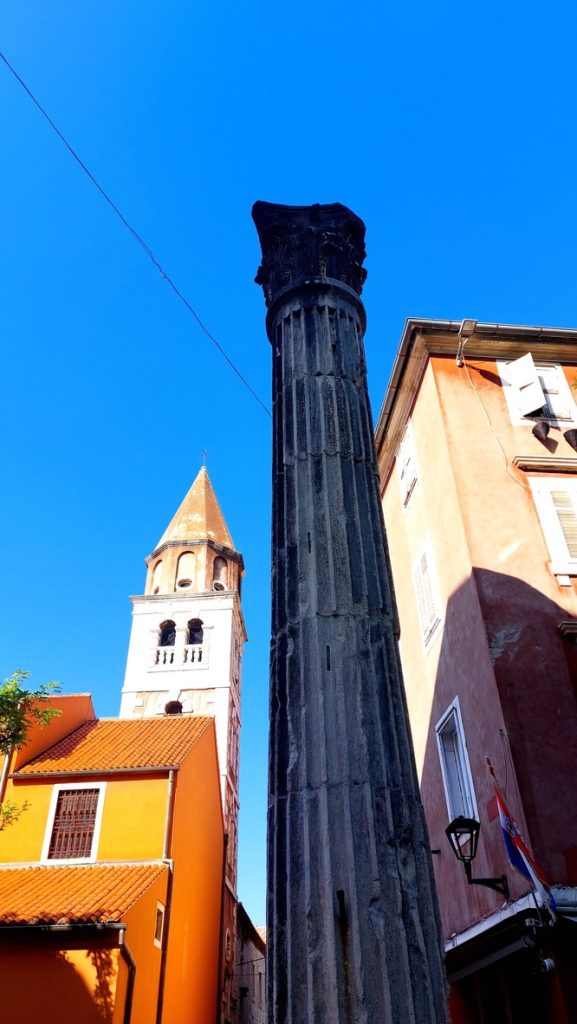
The Archaeological Museum of Zadar
And then there is Zadar’s Archaeological Museum. One of the oldest museums in Croatia, closely related to the Church of Saint Donatus.
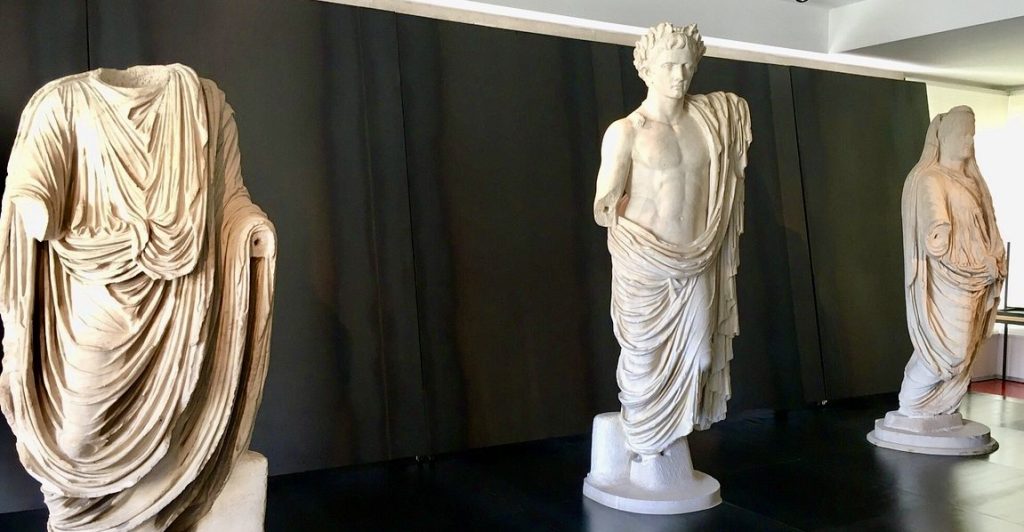
Besides many Roman & religious artifacts, in this museum you’ll find a nice collection of Prehistoric artifacts – weapons, tools, pottery. As well as some fascinating finds done by the museum’s underwater archaeology projects.
TravelTips: In a few words, if you really want to know more about Zadar’s long history, I highly recommend you to visit this museum. It’s located very near the Saint Donatus church, closer even to the Roman Forum.
Other museums to visit in Zadar
Depending on your interests, there are several other fascinating museums in Zadar worth a visit:
Click on their names to learn more:
- Museum of Ancient Glass: Explore the local history of glass making with a collection of ancient artifacts. Besides live glass blowing demonstrations.
- National Museum Zadar: In this museum you can learn all about the region’s ethnology & natural history.
- Museum of Illusions: For some fun, in this museum you can challenge your senses with optical illusions & interactive exhibits.
- Museum of Salt: Discover the history of salt production in the region. (WARNING: This very interesting museum is located in Nin, 20 minutes from Zadar)
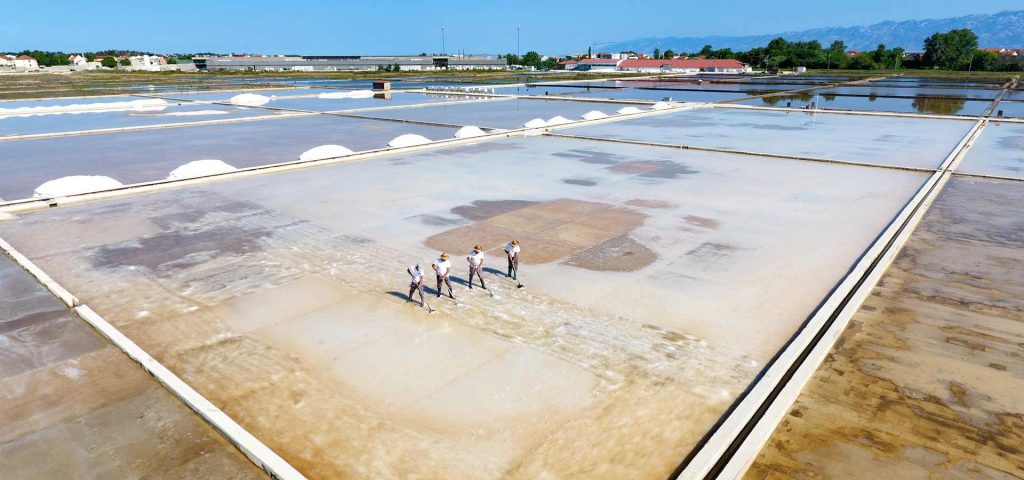
Visit the Riva of Zadar
The Riva is Zadar’s spacious Waterfront Promenade. A place where people go to relax, have a drink and/or a bite, watch people go by & enjoy views of the Adriatic.
That said, Zadar is famous for its sunset. A grandiose natural event you can experience every sun-shining evening. It’s the main reason why every late afternoon – certainly during the summer months – hundreds of people start gathering on the Riva.
Preferably on or around two modern attractions, located on Zadar’s promenade.
The Sea Organ
Zadar’s Sea Organ is an art object, which produces unique, somewhat hallucinating tunes when seawaves enter the holes/tubes hidden in the marble steps you sit or stand on (see photo below).

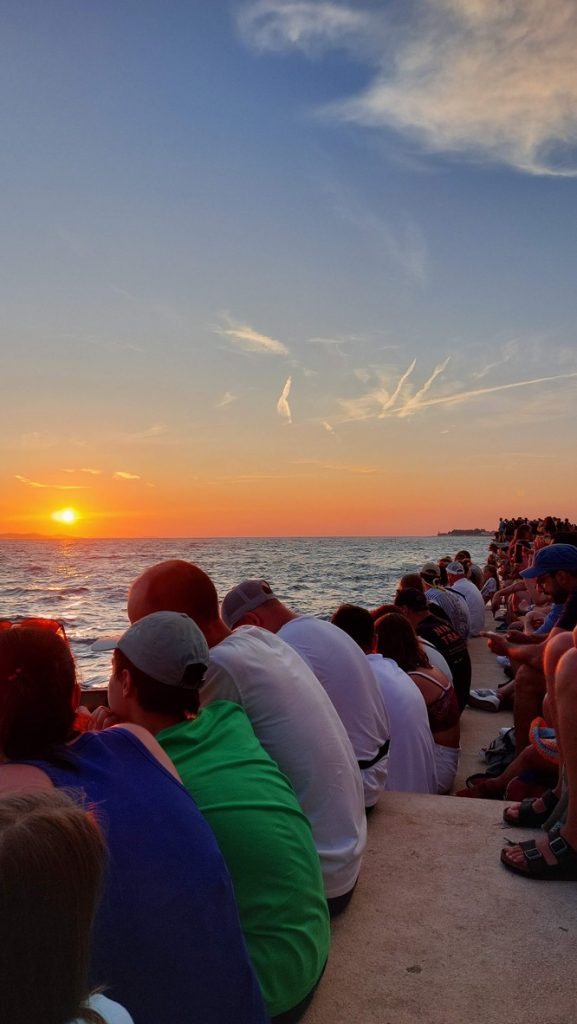
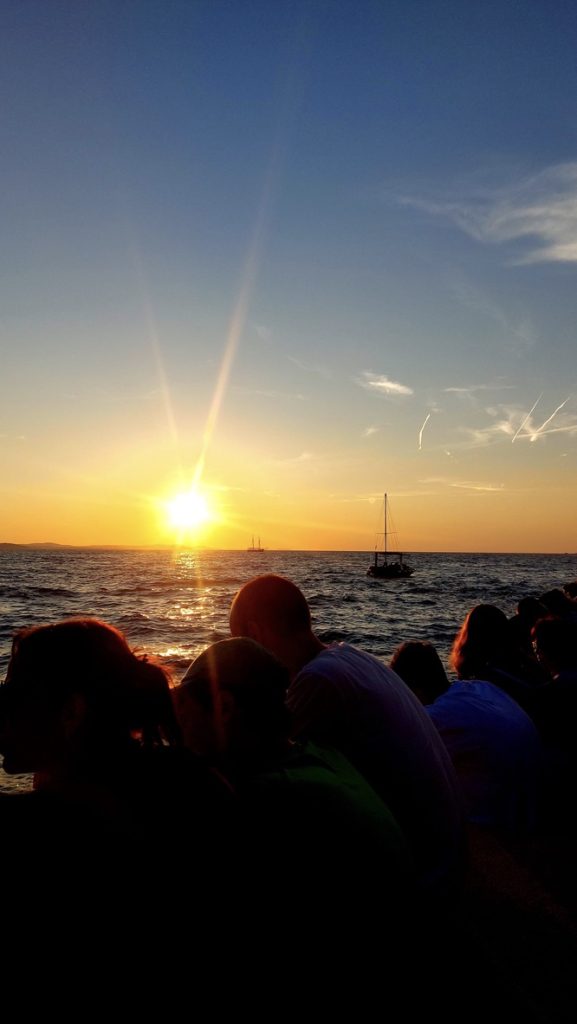

Waiting for the sun to set, while the waves are playing a unique tune on Zadar’s Sea Organ.
TravelTip: Because we were visiting in August and knew beforehand it would get crowded, we arrived early at the steps. Bringing a bottle of wine & some snacks with us, we settled on a first class seat to enjoy the sunset. A real spectacle, which was presented to us soon enough.
The “Greeting to the Sun” monument
The “Greeting to the Sun” monument is another must visit on Zadar’s boulevard. Also preferably when the sun starts setting. That’s the moment when this 22-diameter photovoltaic solar disk comes to life. Providing every visitor with a beautiful light show! A show, this time, fed by the sun.
- Both the Sea Organ & the Greeting of the Sun monument are created by the Croatian architect Nikola Bašić.

Walking Tours of Zadar
If you stay the night in Zadar you’ll automatically have time to stroll the beautiful inner city & get a feel of its past. If however, you want to learn more of its history & other interesting facts, I highly recommend you to join a guided walking tour.
We chose the Historical Walking Tour of Zadar, which was led by a professional local guide. A tour in which the city’s tumultuous past really came alive.
- The guide told us many interesting, as well as fun facts, but also knew exactly where the Roman past was hidden in every church, square or corner. It was really fascinating to see how the visible Zadar is actually built on Roman foundations.

To learn more, go to: Zadar’s History Walking Tour
TravelTips: Personal Safety
We felt absolutely safe during our visit to Zadar. It didn’t matter in what part of town we were, nor if it was during the day or at night.
TravelTip: However, as with any tourist destination, it’s important to exercise common sense & take certain precautions. Just always be aware of your surroundings & don’t display personal valuables openly.

TravelTips: Getting around in Zadar & surrounding area
As in Split & Šibenik we walked a lot. Also because in Zadar you can only explore the inner city on foot.
TravelTip: As a consequence, you’ll need a good pair of walking shoes. Professional footwear you’ll need to explore the city & its natural surroundings.
To get to the attractions in the surrounding area of Zadar, you can – if you don’t have your own (rental) car – either use public transport, or go on a tour.
To gain time & sometimes also money, and to fully enjoy a day-trip around Zadar, I highly recommend you to take a well organised tour, including transport, tickets & a professional guide.
Beaches to visit near Zadar
There are several beach areas within walking distance from Zadar’s city center. The nearest being the Golden Wave Beach. And the most popular, Kolovare Beach.
Both blessed with crystal clear water. Ideal for a refreshing dive in the Adriatic, sunbathing & water sports (certainly during the warmer months, May until October).

TravelTip: As parts of the Dalmatian coast are pretty rough still, I highly recommend you to buy some water shoes. Mainly protecting your feet against stones, sharp rock & sea urchins.
Popular Day Trips from Zadar
There are actually many day trips organized from Zadar. Generally the guided tours to the nearby National Parks are favorite. Being it tours inland or boat trips to the islands nearby.
Day Trip to the Plitvice Lake Area
A beautiful inland tour (9 hours) brings you to the beautiful Plitvice Lake Area (16 interconnected lakes). A unique area, a real natural gem.
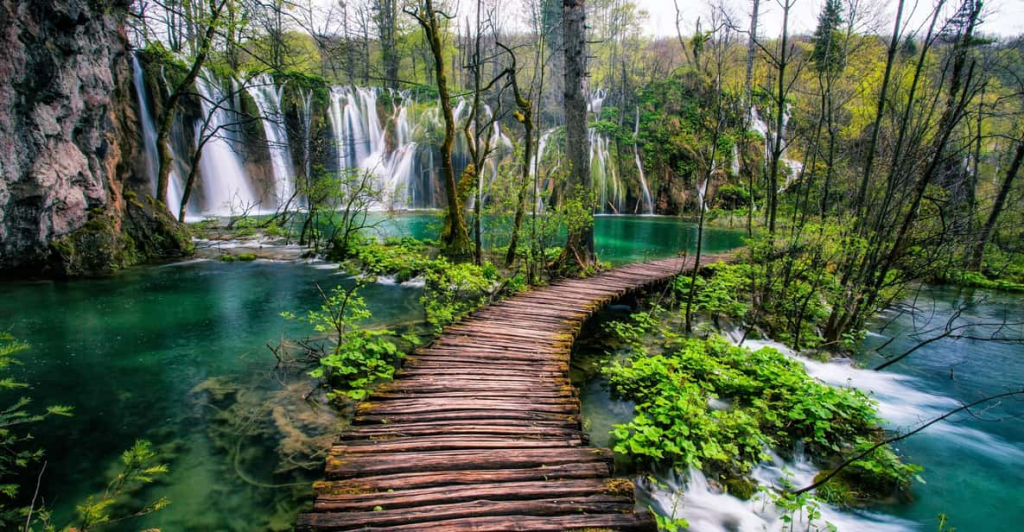
- The drive from Zadar to the Plitvice lakes is about 2 hours, but leads through a beautiful mountainous area.
To learn more, go to: Visit to the Plitvice Lakes from Zadar
The tour above includes entrance tickets & transport to and from the lakes.
If you plan to get there on your own – be it with your own (rental) car or with public transport – you need to Buy your Plitvice entrance tickets in advance. Mainly because there is a daily visitor quota to protect the area against overcrowding.
To learn if tickets for the Krka National Park are still available for a certain date, you can use the widget below:
Visit the Krka Waterfalls
Closer to Zadar you can visit The Krka Lakes & Waterfalls on a day-trip (8 hours). Again a unique natural park – somewhat rougher & more adventurous than Plitvice – you wouldn’t want to miss when in its neighborhood.

- The bus ride to Krka from Zadar will take a little over 1 hour.
To learn more, click on: Trip to the Krka National Park from Zadar
Telašćica & Kornati Island Boat Trip from Zadar
Another popular Full Day Nature trip (10 hours) leads to Telašćica National Park & Kornati Island. A relaxing boat cruise through the Mediterranean waters, with several stops, breakfast & lunch included.

To learn more, go to: Telašćica National Park & Kornati Island Boat Tour
From Zadar: Half-a-Day Island Hopping Tour
A shorter boat tour (4 hours) on the Adriatic Sea near Zadar is the Island Hopping Tour. A fun tour which includes visits to small towns & islands along the coast. As well as some stops for sunbathing, swimming & snorkeling.

To learn more, click on: Zadar Island Hopping Tour
Culinary Tips for your visit to Zadar
Restaurant tips for Zadar
By far the best restaurant we visited in Zadar was The Botanist. A Vegan/Vegetarian restaurant – without us being either – we highly enjoyed. Besides uniquely prepared excellent food, the restaurant had a nice ambience & friendly service.



Impressions of the plates we chose at the Botanist, a vegan/vegetarian restaurant in Zadar, Croatia.
Another culinary stop we liked was at the Fish House Zadar. This restaurant serves plates which sound like fast food, but with a twist. A Fresh Fish twist. We especially enjoyed the Tuna Burger & Tuna Tacos.
If you want to learn more about the culinary map of Zadar: the best restaurants, the local products & food shops I’d like to recommend you to go on a Culinary Walking Tour.

To learn more, click on: Culinary walking tour of Zadar
Bar tips for Zadar
Besides good restaurants, Zadar offers a rich nightlife. Not only for foreign tourists, but also – as we noticed – for the locals themselves.
So, after dinner, we had a good time at the Ledana Lounge & Bar – located in the middle of an urban park. If not the Svarog Bar & Dancing, which had some professional DJ’s working for them at night.
In conclusion: A visit to Zadar
After Split & Šibenik, Zadar was another positive experience. A beautiful city with a long, restless, but fascinating history. A fact you soon enough notice & feel when you walk its streets, looking out for the impressive monuments often built on Roman foundations.
Besides the inspiring inner city, there’s a relaxing promenade connecting you in sound & vision with the Adriatic Sea in front.
Last, but not least: Zadar is a perfect base to visit natural attractions in the surrounding area. Bus tours to the Plitvice Lake area or Krka National park. Boat tours to the islands in front of Zadar, to explore, swim, snorkel & relax.
Some last Photo Impressions of our visit to Zadar



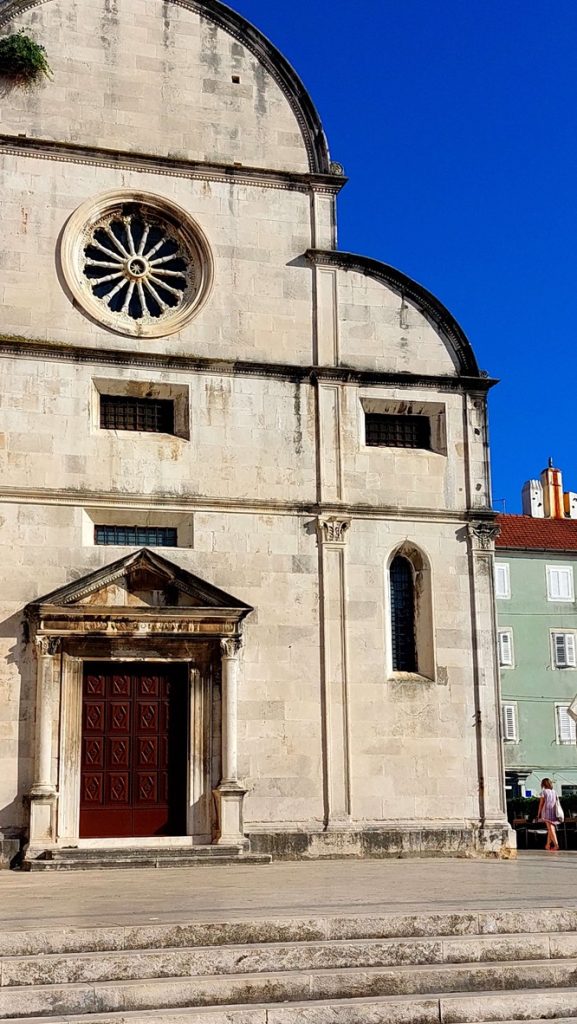
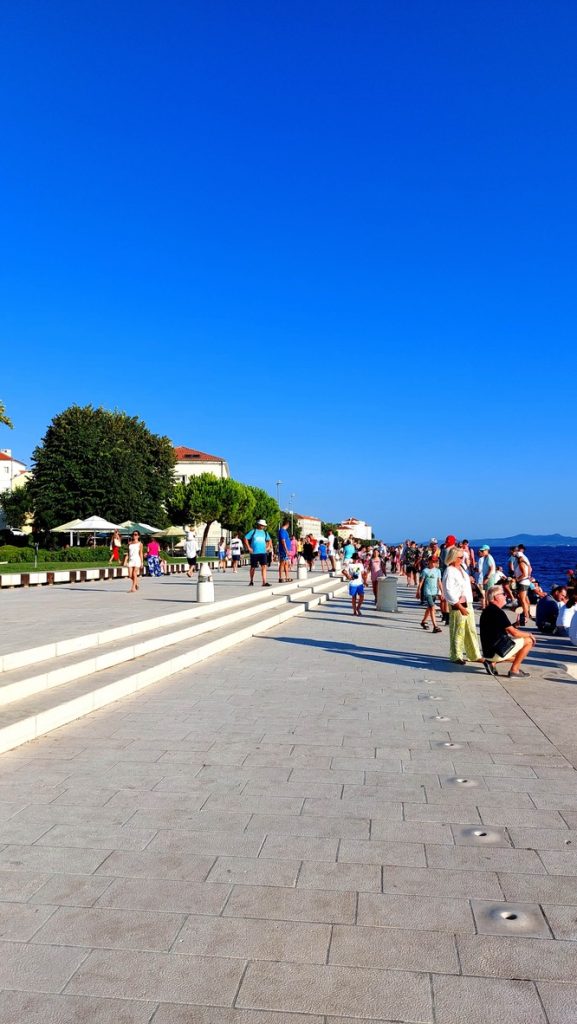
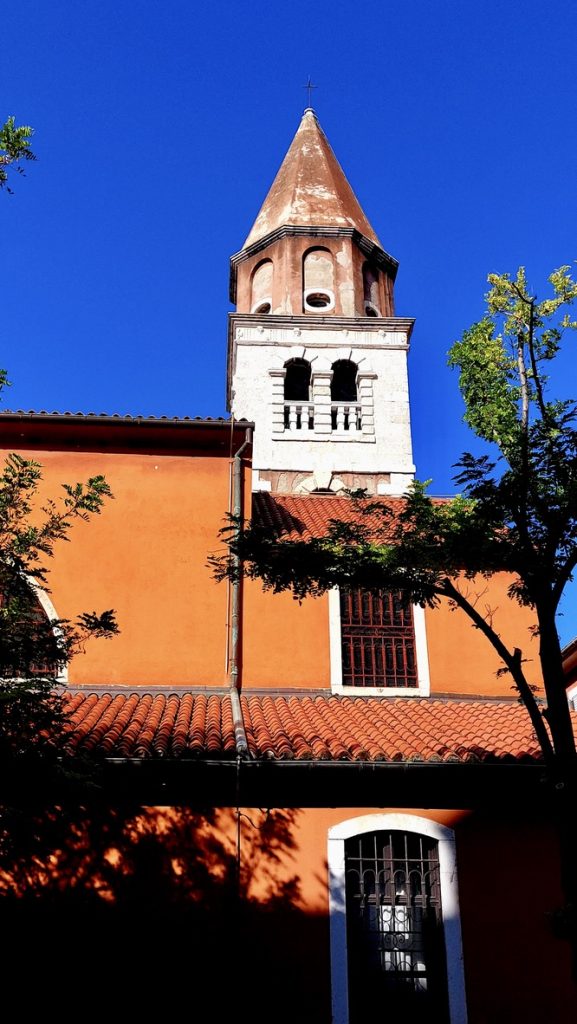
- The story goes – told by our touring guide – that a Venetian priest, returning from the Holy Land, was carrying Saint Simon’s remains back to his home city. When caught in a storm, he sought refuge in Zadar & somehow didn’t make it through the night.
- Thereupon, the townspeople decided to hide the saint’s remains in a secret location. And he would have stayed hidden, if – many years later, when Zadar was plagued by a mysterious illness – his remains weren’t miraculously rediscovered & were given its proper burial in a church that nowadays carries his name.
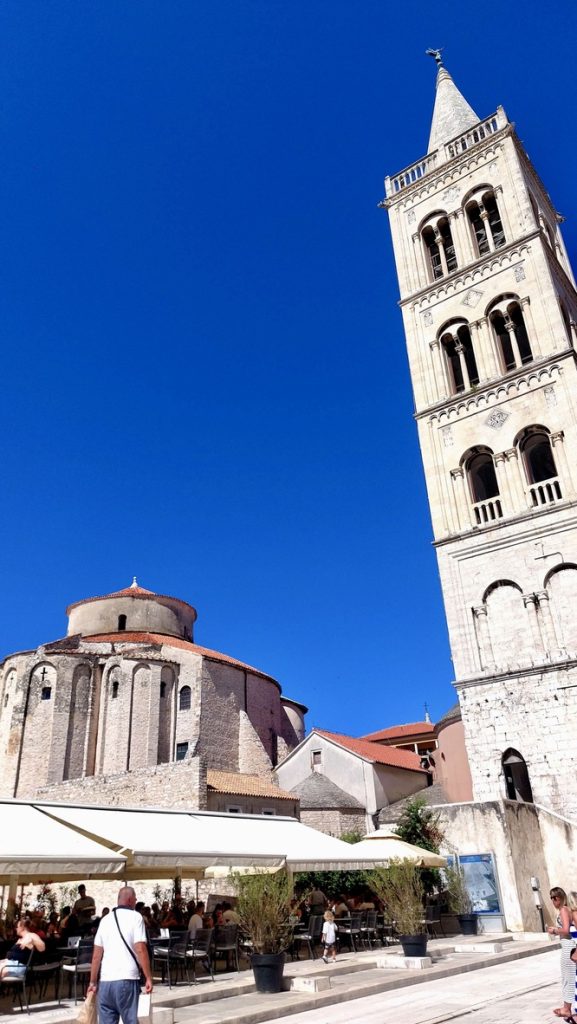
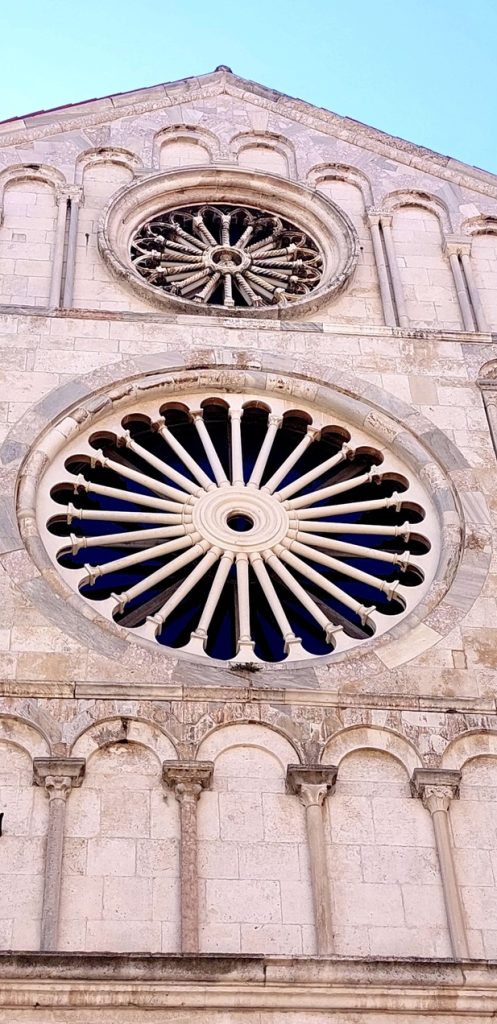
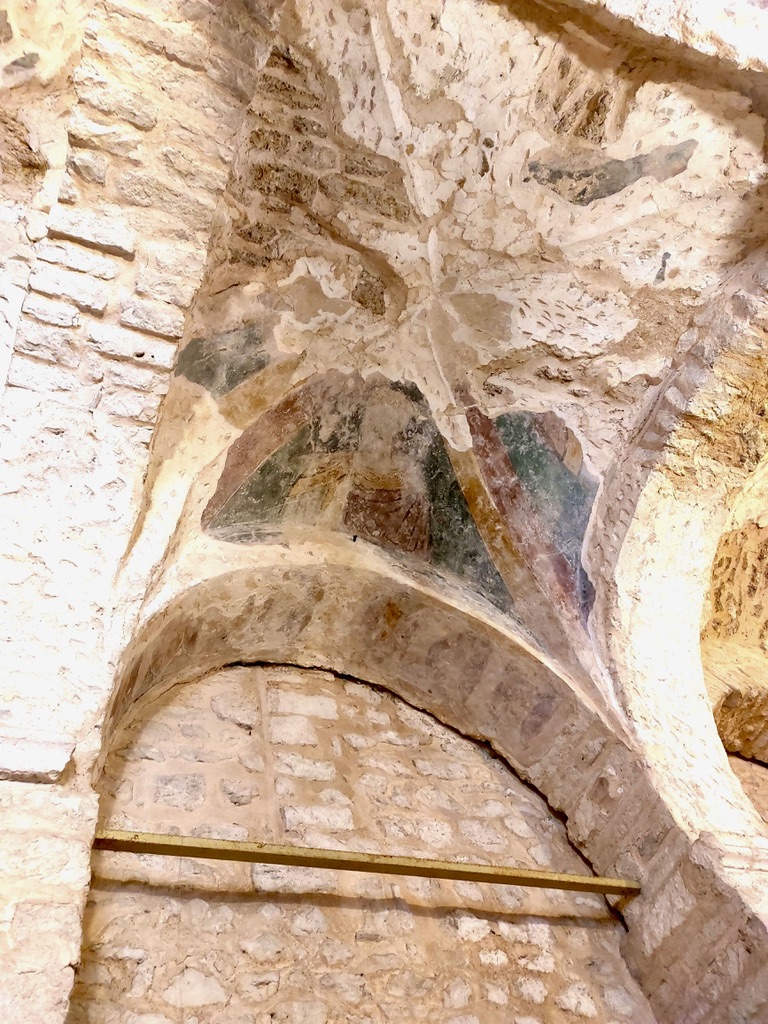
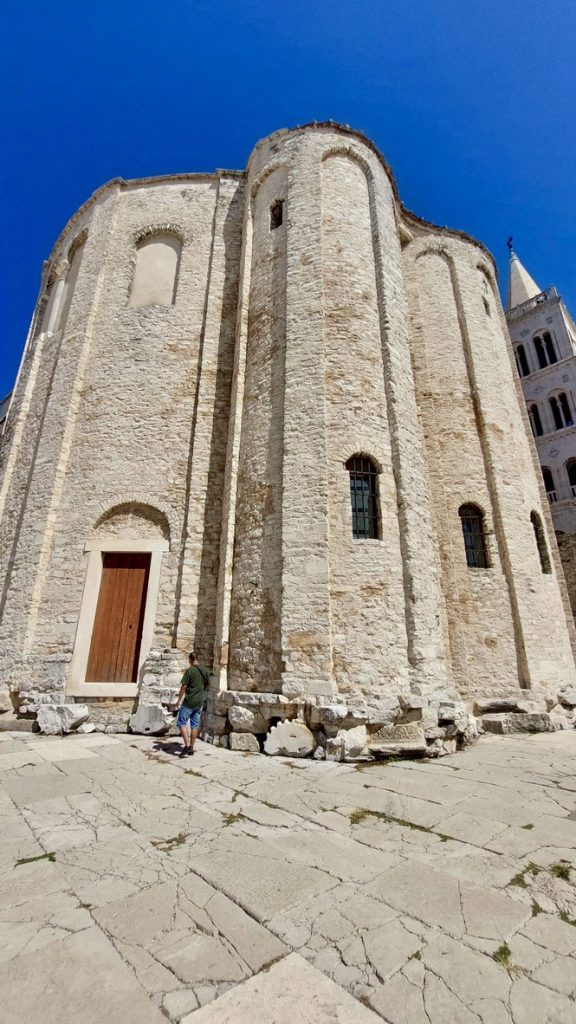
For more information of our earlier stops in beautiful Croatia, go to:
For an overview of all travel posts of my blog, go to: My Home Page

